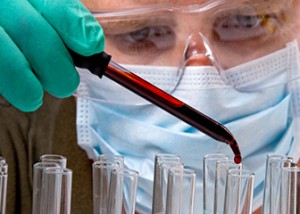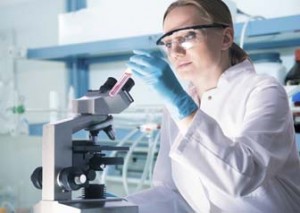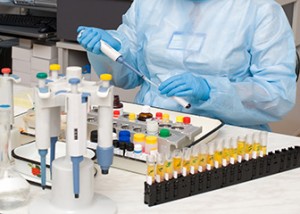Medical laboratory technicians, also known as clinical laboratory technicians, perform routine tests in medical laboratories. These tests help physicians and other professional medical personnel diagnose and treat disease. Technicians prepare samples of body tissue; perform laboratory tests, such as urinalysis and blood counts; and make chemical and biological analyses of cells, tissue, blood, or other body specimens. They usually work under the supervision of a medical technologist or a laboratory director. Medical laboratory technicians may work in many fields, or specialize in one specific medical area, such as cytology (the study of cells), hematology (the study of blood, especially on the cellular level), serology (the study and identification of antibodies found in the blood), or histology (the study of body tissue). There are approximately 302,000 medical laboratory technicians and technologists employed in the United States.
Medical laboratory technology shares many important milestones with the history of medicine itself. For instance, both fields can claim as their founder Aristotle, the father of biology and physiology. Some significant achievements include Jan Swammerdam’s discovery of red blood corpuscles in 1658; Anton van Leeuwenhoek’s observation of microorganisms through the microscope during the latter part of the 17th century; and the discoveries of Robert Koch and Louis Pasteur in bacteriology in the 1870s.
The valuable information gained through these efforts showed medical professionals many possibilities for therapy, especially in the medical specialties of bacteriology (the study of microorganisms in the human body), cytology, histology, and hematology. The growth of these medical specialties created a steadily increasing need for laboratory personnel.
Because of the great medical advances of the 20th century, physicians are even more dependent on laboratory procedures and personnel for assistance in diagnosing and treating disease. In the early part of this century, individual physicians often taught their assistants how to perform some of the laboratory procedures frequently employed in their practices. Because the quality of work done by these technicians varied considerably, many physicians and medical educators became concerned with the problem of ensuring that assistants did the highest quality work possible. In 1936, one of the first attempts was made to standardize the training programs for the preparation of skilled assistants—in that case, the training of medical technologists. Since then, the National Accrediting Agency for Clinical Laboratory Sciences, in association with the Committee on Allied Health Education and Accreditation of the American Medical Association (CAHEA), has instituted standards of training for medical laboratory technicians. CAHEA accredits educational programs offered in community, junior, and technical colleges for the training of medical laboratory technicians, and other accrediting agencies have also entered the field. For example, the Accrediting Bureau of Health Education Schools accredits education programs for medical laboratory technicians and medical assistants. In addition, CAHEA and other agencies have accredited dozens of other programs for students willing to concentrate their studies in a medical laboratory specialty such as cytology, histology, or blood bank technology.
Medical Laboratory Technician Job Description
 Medical laboratory technicians may be generalists in the field of laboratory technology; that is, they may be trained to carry out many different kinds of medical laboratory work. Alternatively, they may specialize in one type of medical laboratory work, such as cytology, hematology, blood bank technology, serology, or histology. The following paragraphs describe the work of generalists and those in the specialty fields of cytology, histology, and blood bank technology.
Medical laboratory technicians may be generalists in the field of laboratory technology; that is, they may be trained to carry out many different kinds of medical laboratory work. Alternatively, they may specialize in one type of medical laboratory work, such as cytology, hematology, blood bank technology, serology, or histology. The following paragraphs describe the work of generalists and those in the specialty fields of cytology, histology, and blood bank technology.
Medical laboratory technicians who work as generalists perform a wide variety of tests and laboratory procedures in chemistry, hematology, urinalysis, blood banking, serology, and microbiology. By performing these tests and procedures, they help to develop vital data on the blood, tissues, and fluids of the human body. This data is then used by physicians, surgeons, pathologists, and other medical personnel to diagnose and treat patients.
The tests and procedures that these technicians perform are more complex than the routine duties assigned to laboratory assistants, but do not require specialized knowledge like those performed by more highly trained medical technologists. In general, medical laboratory technicians work with only limited supervision. This means that while the tests they perform may have well-established procedures, the technicians themselves must exercise independent judgment. For instance, they must be able to discriminate between very similar colors or shapes, correct their own errors using established strategies, and monitor ongoing quality control measures.
To carry out these responsibilities, medical laboratory technicians need a sound knowledge of specific techniques and instruments and must be able to recognize factors that potentially influence both the procedures they use and the results they obtain.
In their work, medical laboratory technicians frequently handle test tubes and other glassware and use precision equipment, such as microscopes and automated blood analyzers. (Blood analyzers determine the levels of certain blood components like cholesterol, sugar, and hemoglobin.) Technicians also are often responsible for making sure machines are functioning and supplies are adequately stocked.
Medical laboratory technicians who specialize in cytology are usually referred to as cytotechnicians. Cytotechnicians prepare and stain body cell samplings using special dyes that accentuate the delicate patterns of the cytoplasm, and structures such as the nucleus. Mounted on slides, the various features of the specimen then stand out brightly under a microscope. Using microscopes that magnify cells perhaps 1,000 times, cytotechnicians screen out normal samplings and set aside those with minute irregularities (in cell size, shape, and color) for further study by a pathologist.
Medical laboratory technicians specializing in histology are usually referred to as histologic technicians or tissue technicians. Histology is the study of the structure and chemical composition of the tissues, and histologic technicians are mainly concerned with detecting tissue abnormalities and assisting in determining appropriate treatments for the disease conditions associated with the abnormalities.
Medical laboratory technicians who specialize in blood bank technology perform a wide variety of routine tests related to running blood banks, offering transfusion services, and investigating blood diseases and reactions to transfusions. Examples of tasks frequently performed by medical laboratory technicians specializing in this field include donor screening, determining blood types, performing tests of patients’ blood counts, and assisting physicians in the care of patients with blood-related problems.
Medical Laboratory Technician Career Requirements
 High School
High School
To be hired as a medical laboratory technician, you must have a high school diploma and one or two years of postsecondary training. No specific kind of high school training is required; however, you must be able to meet the admissions requirements of institutions offering post-high school training. In general, courses in biology, chemistry, mathematics, English, and computer science will be most helpful in a career as a medical laboratory technician.
Postsecondary Training
After high school, prospective technicians enroll in one-or two-year training programs accredited by the American Medical Association’s Committee on Allied Health Education and Accreditation, the Accrediting Bureau of Health Education Schools, or the National Accrediting Agency for Clinical Laboratory Sciences, which fully accredits 469 programs. One-year programs include both classroom work and practical laboratory training and focus on areas such as medical ethics and conduct, medical terminology, basic laboratory solutions and media, manipulation of cytological and histological specimens, blood collecting techniques, and introductions to basic hematology, serology, blood banking, and urinalysis.
To earn an associate’s degree, you must complete a two-year post-high school program. Like certificate programs, associate’s degree programs include classroom instruction and practical training. Courses are taught both on campus and in local hospitals. On-campus courses focus on general knowledge and basic skills in laboratory testing associated with hematology, serology, chemistry, microbiology, and other pertinent biological and medical areas. The clinical training program focuses on basic principles and skills required in medical diagnostic laboratory testing.
Certification or Licensing
Students who have earned an associate’s degree are eligible for certification from several different agencies, including the Board of Registry of the American Society for Clinical Pathology, the American Medical Technologists, the National Credentialing Agency for Laboratory Personnel, and the American Association of Bioanalysts.
Prospective medical laboratory technicians who think they might want to specialize in cytology or blood bank technology should definitely consider the two-year program, which will best prepare them for the additional education they may need later.
In addition to completing the educational programs described above, prospective technicians need to pass an examination after graduation to receive certification. In some states, this certificate is all that is required for employment. In other states, state licensure is also required. School officials are the best source of information regarding state requirements.
Other Requirements
Besides fulfilling the academic requirements, medical laboratory technicians must have good manual dexterity, normal color vision, the ability to follow instructions, and a tolerance for working under pressure.
Exploring Medical Laboratory Technician Career
 It is difficult for people interested in a career in medical laboratory technology to gain any direct experience through part-time employment. There are some other ways, however, to learn more about this career on a firsthand basis. Perhaps the best way is to arrange a visit to a hospital, blood bank, or commercial medical laboratory to see technicians at work at their jobs. Another way to learn about this kind of work in general, and about the training required in particular, is to visit an accredited school of medical laboratory technology to discuss career plans with the admissions counselor at the school. You can also write to the sources listed at the end of this article for more reading material on medical laboratory technology. Finally, you should remember that high school science courses with laboratory sections will give you exposure to some of the kinds of work you might do later in your career.
It is difficult for people interested in a career in medical laboratory technology to gain any direct experience through part-time employment. There are some other ways, however, to learn more about this career on a firsthand basis. Perhaps the best way is to arrange a visit to a hospital, blood bank, or commercial medical laboratory to see technicians at work at their jobs. Another way to learn about this kind of work in general, and about the training required in particular, is to visit an accredited school of medical laboratory technology to discuss career plans with the admissions counselor at the school. You can also write to the sources listed at the end of this article for more reading material on medical laboratory technology. Finally, you should remember that high school science courses with laboratory sections will give you exposure to some of the kinds of work you might do later in your career.
Employers
Medical laboratory technicians are employed where physicians work, such as in hospitals, clinics, offices of physicians, blood blanks, and commercial medical laboratories. Approximately 302,000 medical laboratory technicians and technologists are employed in the United States, with more than half working in hospitals.
Starting Out
Graduates of medical laboratory technology schools usually receive assistance from faculty and school placement services to find their first jobs. Hospitals, laboratories, and other facilities employing medical laboratory technicians may notify local schools of job openings. Often the hospital or laboratory at which you receive your practical training will offer full-time employment after graduation. Positions may also be secured using the various registries of certified medical laboratory workers. Newspaper job advertisements and commercial placement agencies are other sources of help in locating employment.
Advancement
Medical laboratory technicians often advance by returning to school to earn a bachelor’s degree. This can lead to positions as medical technologists, histological technologists, cytotechnologists, or specialists in blood bank technology.
Other technicians advance by gaining more responsibility while retaining the title of technician. For instance, with experience, these workers can advance to supervisory positions or other positions assigning work to be done by other medical laboratory workers. Medical laboratory technicians may also advance by training to do very specialized or complex laboratory or research work.
Earnings
Salaries of medical laboratory technicians vary according to employer and geographical area. According to the U.S. Bureau of Labor Statistics, median annual earnings of medical and clinical laboratory technicians were $31,440 in November 2004. Salaries ranged from less than $20,570 to more than $47,110. Fifty percent of workers in this field earned between $25,170 and $38,780 annually at the end of2004. Medical laboratory technicians who go on to earn their bachelor’s degrees and certification as medical technologists can expect an increase in annual earnings.
Most medical laboratory technicians receive paid vacations and holidays, sick leave, health insurance, and retirement benefits.
Work Environment
Medical laboratory technicians work in clean, well-lit, and usually air-conditioned settings. There may, however, be unpleasant odors and some infectious materials involved in the work. In general, there are few hazards associated with these odors and materials as long as proper methods of sterilization and handling of specimens, materials, and equipment are used.
Medical laboratory technicians often spend much of their days standing or sitting on stools. A 40-hour, five-day week is normal, although those working in hospitals can expect some evening and weekend work.
Medical laboratory technicians derive satisfaction from knowing their work is very important to patients and their physicians. Although the work involves new patient samples, it also involves some very repetitive tasks that some people may find trying. Additionally, the work must often be done under time pressure, even though it is often very painstaking.
Another factor that aspiring medical laboratory technicians should keep in mind is that advancement opportunities are limited, although they do exist. To maximize their chances for advancement, medical laboratory technicians must consider getting additional training.
Medical Laboratory Technician Career Outlook
The U.S. Department of Labor predicts job growth for medical laboratory technicians to be faster than the average through 2014. Competition for jobs, however, may be strong. One reason for this increased competition is the overall national effort to control health care costs. Hospitals, where most medical laboratory technicians are employed, will seek to control costs in part through cutting down on the amount of laboratory testing they do and, consequently, the personnel they require.
Despite such cutbacks, though, the overall amount of medical laboratory testing will probably increase, as much of medical practice today relies on high-quality laboratory testing. However, because of the increased use of automation, this increase in laboratory testing probably will not lead to an equivalent growth in employment.
One other technological factor that will influence employment in this field is the development of laboratory-testing equipment that is easier to use. This means that some testing that formerly had to be done in hospitals can now be done in physicians’ offices and other non-hospital settings. This development will slow growth in hospital laboratory employment; however, it should increase the number of technicians hired by medical groups and clinics, medical and diagnostic laboratories, and other ambulatory health care services such as blood and organ banks. In addition, equipment that is easier to use may also lead to technicians being able to do more kinds of testing, including some tests that used to be done only by medical technologists.
Despite these growth projections, aspiring technicians should keep in mind that medical laboratory testing is an absolutely essential element in today’s medicine. For well-trained technicians who are flexible in accepting responsibilities and willing to continue their education throughout their careers, employment opportunities should remain good.
For More Information:
- Computer Science Careers
- American Association of Bioanalysts
- American Medical Technologists
- American Society for Clinical Laboratory Science